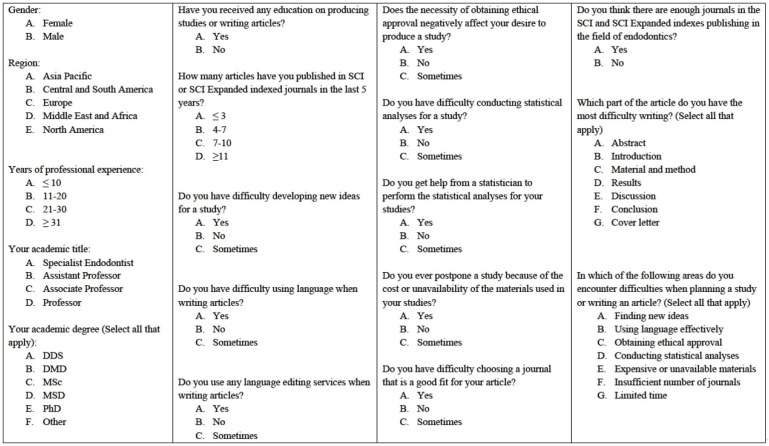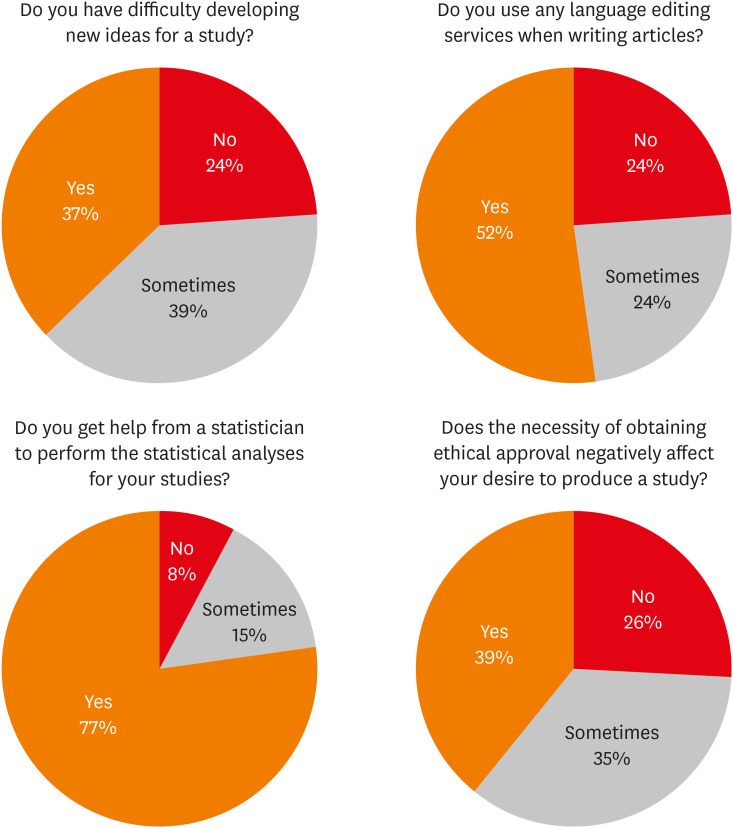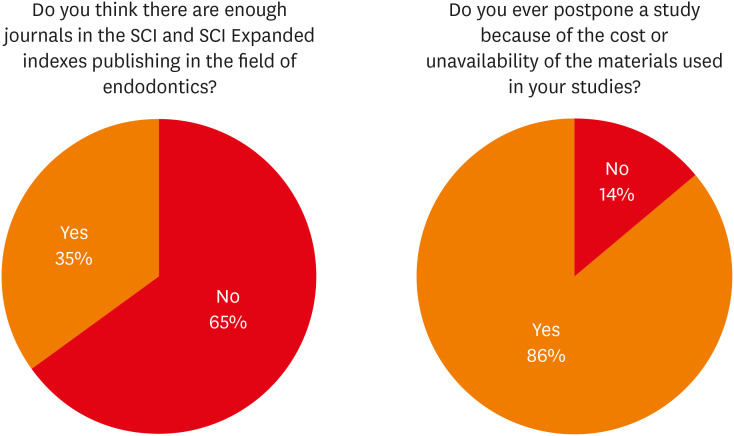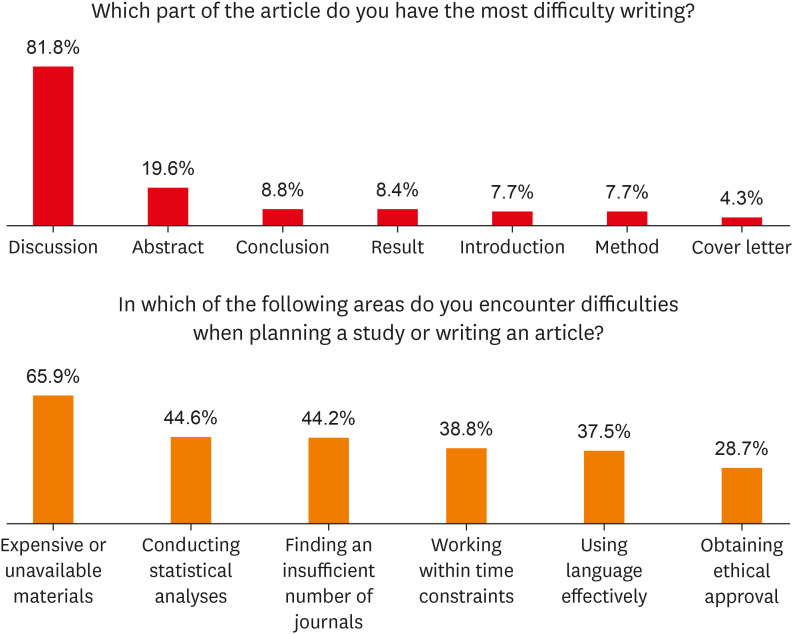Restor Dent Endod.
2022 May;47(2):e20. 10.5395/rde.2022.47.e20.
Difficulties experienced by endodontics researchers in conducting studies and writing papers
- Affiliations
-
- 1Department of Endodontics, Faculty of Dentistry, Bezmialem Vakif University, Istanbul, Turkey
- 2Department of Endodontics, Faculty of Dentistry, Marmara University, Istanbul, Turkey
- 3Clinical Practice Limited to Endodontics, Navegantes, Santa Catarina, Brazil
- KMID: 2548124
- DOI: http://doi.org/10.5395/rde.2022.47.e20
Abstract
Objectives
The study investigated the difficulties experienced by endodontics researchers around the world in conducting studies and writing papers.
Materials and Methods
A survey consisting of 18 questions on the difficulties experienced by endodontics researchers in performing studies and writing papers was e-mailed to academics in the field of endodontics working at 202 universities. The independent risk factors were analyzed using binary logistic regression at a significance level of 0.05.
Results
A total of 581 individuals (10.7%) agreed to participate in the study. Almost half the participants (48.2%) reported that they had received some type of training in conducting studies and writing papers. In response to the question, “Do you get help from a statistician to perform the statistical analyses of your studies?,” 77.1% answered “yes.” Around 40% of the participants stated that the need to obtain ethical approval negatively affected their desire to conduct studies. The participants’ regions had no effect on the reported difficulties associated with writing papers in English or conducting statistical analyses (p > 0.05). Most participants (81.8%) reported difficulties in writing the Discussion section, regardless of their region, academic degrees, or years of experience.
Conclusions
The participants stated they experienced difficulties in many areas, such as conducting statistical analyses, finding new ideas, and writing in English. Engaging in a detailed examination of ethics committee rules, expanding biostatistics education, increasing the number of institutions providing research funding, and increasing the number of endodontics journals can increase the enthusiasm of endodontics researchers to publish papers.
Keyword
Figure
Reference
-
1. Chiappelli F, Prolo P, Newman M, Cruz M, Sunga E, Concepcion E, Edgerton M. Evidence-based practice in dentistry: benefit or hindrance. J Dent Res. 2003; 82:6–7. PMID: 12508036.2. Sellars S. How evidence-based is dentistry anyway? From evidence-based dentistry to evidence-based practice. Br Dent J. 2020; 229:12–14. PMID: 32651511.
Article3. Kotz D, Cals JW. Effective writing and publishing scientific papers, part IV: methods. J Clin Epidemiol. 2013; 66:817. PMID: 23434330.
Article4. Kotz D, Cals JW. Effective writing and publishing scientific papers - Part I: how to get started. J Clin Epidemiol. 2013; 66:397. PMID: 23452726.5. Cals JW, Kotz D. Effective writing and publishing scientific papers, part VI: discussion. J Clin Epidemiol. 2013; 66:1064. PMID: 23993311.
Article6. Cals JW, Kotz D. Effective writing and publishing scientific papers, part X: choice of journal. J Clin Epidemiol. 2014; 67:3. PMID: 24183607.
Article7. Kotz D, Cals JW. Effective writing and publishing scientific papers, part XII: responding to reviewers. J Clin Epidemiol. 2014; 67:243. PMID: 24411072.
Article8. Neuppmann Feres MF, Roscoe MG, Job SA, Mamani JB, Canto GL, Flores-Mir C. Barriers involved in the application of evidence-based dentistry principles: a systematic review. J Am Dent Assoc. 2020; 151:16–25.e16. PMID: 31902396.9. El-Serag HB. Writing and publishing scientific papers. Gastroenterology. 2012; 142:197–200. PMID: 22178211.
Article10. Wajsberg J. Michael D. Gordin. Scientific babel: how science was done before and after global English. Chicago: University of Chicago Press, 2015. 424 pp. $30.00 (cloth). ISBN-13: 9780226000299. J Hist Behav Sci. 2016; 52:315–317.
Article11. Ramírez-Castañeda V. Disadvantages in preparing and publishing scientific papers caused by the dominance of the English language in science: The case of Colombian researchers in biological sciences. PLoS One. 2020; 15:e0238372. PMID: 32936821.
Article12. World Medical Association. World Medical Association Declaration of Helsinki: ethical principles for medical research involving human subjects. JAMA. 2013; 310:2191–2194. PMID: 24141714.13. Gelbier S, Wright D, Bishop M. Ethics and dentistry: I. The meaning of ethics. Dent Update. 2001; 28:468–473. PMID: 11806191.14. Kotz D, Cals JW, Tugwell P, Knottnerus JA. Introducing a new series on effective writing and publishing of scientific papers. J Clin Epidemiol. 2013; 66:359–360. PMID: 23452725.15. Krithikadatta J, Valarmathi S. Research methodology in dentistry: Part II - The relevance of statistics in research. J Conserv Dent. 2012; 15:206–213. PMID: 22876003.
Article16. Tsotsis P, Dunlap C, Scott R, Arias A, Peters OA. A survey of current trends in root canal treatment: access cavity design and cleaning and shaping practices. Aust Endod J. 2021; 47:27–33. PMID: 33030288.
Article17. Dutner J, Mines P, Anderson A. Irrigation trends among American Association of Endodontists members: a web-based survey. J Endod. 2012; 38:37–40. PMID: 22152617.
Article18. Deniz-Sungur D, Aksel H, Karaismailoglu E, Sayin TC. The prescribing of antibiotics for endodontic infections by dentists in Turkey: a comprehensive survey. Int Endod J. 2020; 53:1715–1727. PMID: 32805741.
Article19. Setzer FC, Hinckley N, Kohli MR, Karabucak B. A survey of cone-beam computed tomographic use among endodontic practitioners in the United States. J Endod. 2017; 43:699–704. PMID: 28292601.
Article20. Tsang S, Royse CF, Terkawi AS. Guidelines for developing, translating, and validating a questionnaire in perioperative and pain medicine. Saudi J Anaesth. 2017; 11(Suppl 1):S80–S89. PMID: 28616007.
Article21. van de Kerke S, Muysken P. The Andean matrix. Muysken PC, O’Connor LM, editors. The native languages of South America. Cambridge: Cambridge University Press;2014. p. 126–151.22. Kinkade MD. The languages of native North America: the languages of native North America. J Linguist Anthropol. 2000; 10:297–298.23. Hanauer DI, Englander K. Quantifying the burden of writing research articles in a second language: data from Mexican scientists. Writ Commun. 2011; 28:403–416.
Article24. Lucena C, Lopez JM, Pulgar R, Abalos C, Valderrama MJ. Potential errors and misuse of statistics in studies on leakage in endodontics. Int Endod J. 2013; 46:323–331. PMID: 22958068.
Article25. Polychronopoulou A, Pandis N, Eliades T. Appropriateness of reporting statistical results in orthodontics: the dominance of P values over confidence intervals. Eur J Orthod. 2011; 33:22–25. PMID: 20631084.
Article26. Souza E. Research that matters: setting guidelines for the use and reporting of statistics. Int Endod J. 2014; 47:115–119. PMID: 24397818.
Article27. Kim JS, Kim DK, Hong SJ. Assessment of errors and misused statistics in dental research. Int Dent J. 2011; 61:163–167. PMID: 21692788.
Article28. Tracy SJ. Qualitative quality: eight “big-tent” criteria for excellent qualitative research. Qual Inq. 2010; 16:837–851.
Article29. Buck K, Nolte L, Kelly H, Detering K, Sinclair C, White BP, Sellars M. Challenges in obtaining research ethics and governance approvals for an Australian national intersector, multisite audit study. Aust Health Rev. 2017; 44:799–805.
Article30. de Lange DW, Guidet B, Andersen FH, Artigas A, Bertolini G, Moreno R, Christensen S, Cecconi M, Agvald-Ohman C, Gradisek P, Jung C, Marsh BJ, Oeyen S, Bollen Pinto B, Szczeklik W, Watson X, Zafeiridis T, Flaatten H. Huge variation in obtaining ethical permission for a non-interventional observational study in Europe. BMC Med Ethics. 2019; 20:39. PMID: 31159853.
Article31. Barnett AG, Campbell MJ, Shield C, Farrington A, Hall L, Page K, Gardner A, Mitchell BG, Graves N. The high costs of getting ethical and site-specific approvals for multi-centre research. Res Integr Peer Rev. 2016; 1:16. PMID: 29451546.
Article32. D’Souza RN, Colombo JS. How research training will shape the future of dental, oral, and craniofacial research. J Dent Educ. 2017; 81:eS73–eS82. PMID: 28864807.33. National Academy of Sciences (US), National Academy of Engineering (US), Institute of Medicine (US) Committee on Maximizing the Potential of Women in Academic Science and Engineering. Beyond bias and barriers: fulfilling the potential of women in academic science and engineering. Washington, D.C.: National Academies Press;2017. p. 1–317.34. Aiston S, Jung J. Women academic and research productivity: an international comparison. Gend Educ. 2015; 27:205–220.35. Ioannidou E, D’Souza RN, Macdougall MJ. Gender equity in dental academics: gains and unmet challenges. J Dent Res. 2014; 93:5–7. PMID: 24144534.36. Halley MC, Rustagi AS, Torres JS, Linos E, Plaut V, Mangurian C, Choo E, Linos E. Physician mothers’ experience of workplace discrimination: a qualitative analysis. BMJ. 2018; 363:k4926. PMID: 30541926.
Article37. Garcia MN, Tiano JP, Contreras O, Hildebolt CF, Horsford J, Stewart D. Trends in academic dentistry and oral health research funding by gender. JDR Clin Trans Res. 2020; 5:176–184. PMID: 31378126.
Article38. Annesley TM. The discussion section: your closing argument. Clin Chem. 2010; 56:1671–1674. PMID: 20833779.
Article39. Ickes MJ, Gambescia SF. Abstract art: how to write competitive conference and journal abstracts. Health Promot Pract. 2011; 12:493–496. PMID: 21730201.
- Full Text Links
- Actions
-
Cited
- CITED
-
- Close
- Share
- Similar articles
-
- Conducting and Writing Quantitative and Qualitative Research
- Proper Scholarly Writing for NonNative English-Speaking Authors: Choosing Active and Passive Voice, Rewording, and Refining Texts
- Techniques of writing medical papers: a practical approach
- Analysis of papers published in the journal of korean academy of conservative dentistry during the last ten years
- Linguistic Study on Sentences in the Textbooks and Papers of the Neuropsychiatric Community





